ECU Citroen DS4 RHD 2013.5 1.G User Guide
[x] Cancel search | Manufacturer: CITROEN, Model Year: 2013.5, Model line: DS4 RHD, Model: Citroen DS4 RHD 2013.5 1.GPages: 400, PDF Size: 31.86 MB
Page 174 of 400
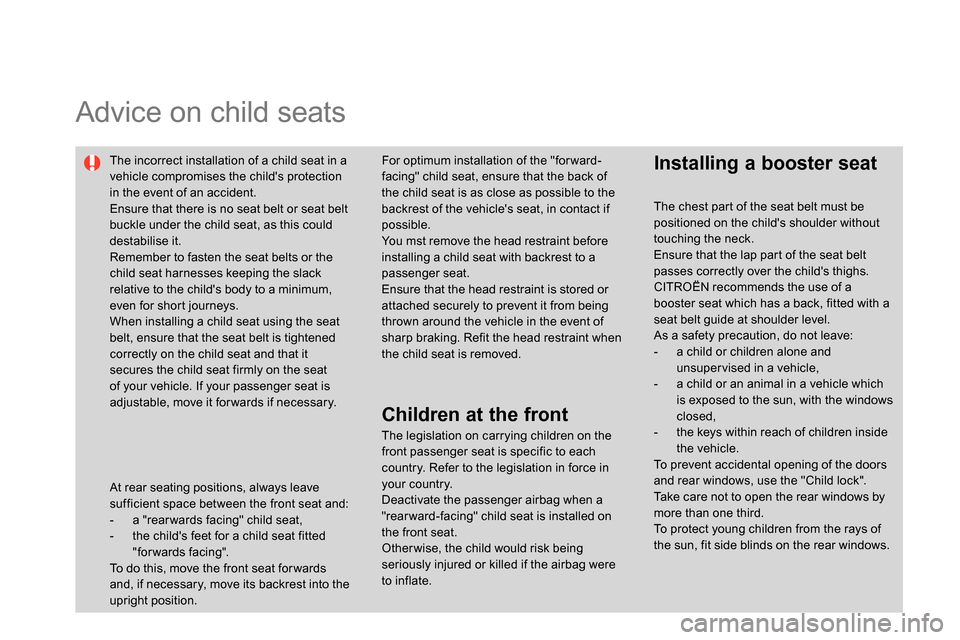
Advice on child seats
The incorrect installation of a child seat in a
vehicle compromises the child's protection
in the event of an accident.
Ensure that there is no seat belt or seat belt
buckle under the child seat, as this could
destabilise it.
Remember to fasten the seat belts or the
child seat harnesses keeping the slack
relative to the child's body to a minimum,
even for short journeys.
When installing a child seat using the seat
belt, ensure that the seat belt is tightened
correctly on the child seat and that it
secures the child seat firmly on the seat
of your vehicle. If your passenger seat is
adjustable, move it for wards if necessary. For optimum installation of the "for ward-
facing" child seat, ensure that the back of
the child seat is as close as possible to the
backrest of the vehicle's seat, in contact if
possible.
You mst remove the head restraint before
installing a child seat with backrest to a
passenger seat.
Ensure that the head restraint is stored or
attached securely to prevent it from being
thrown around the vehicle in the event of
sharp braking. Refit the head restraint when
the child seat is removed.
Installing a booster seat
The chest part of the seat belt must be
positioned on the child's shoulder without
touching the neck.
Ensure that the lap part of the seat belt
passes correctly over the child's thighs.
CITROËN recommends the use of a
booster seat which has a back, fitted with a
seat belt guide at shoulder level.
As a safety precaution, do not leave:
- a child or children alone and
unsuper vised in a vehicle,
- a child or an animal in a vehicle which
is exposed to the sun, with the windows
closed,
- the keys within reach of children inside
the vehicle.
To prevent accidental opening of the doors
and rear windows, use the "Child lock".
Take care not to open the rear windows by
more than one third.
To protect young children from the rays of
the sun, fit side blinds on the rear windows.
At rear seating positions, always leave
sufficient space between the front seat and:
- a "rear wards facing" child seat,
- the child's feet for a child seat fitted
"for wards facing".
To do this, move the front seat for wards
and, if necessary, move its backrest into the
upright position.
Children at the front
The legislation on carrying children on the
front passenger seat is specific to each
country. Refer to the legislation in force in
your country.
Deactivate the passenger airbag when a
"rear ward-facing" child seat is installed on
the front seat.
Other wise, the child would risk being
seriously injured or killed if the airbag were
to inflate.
Page 186 of 400
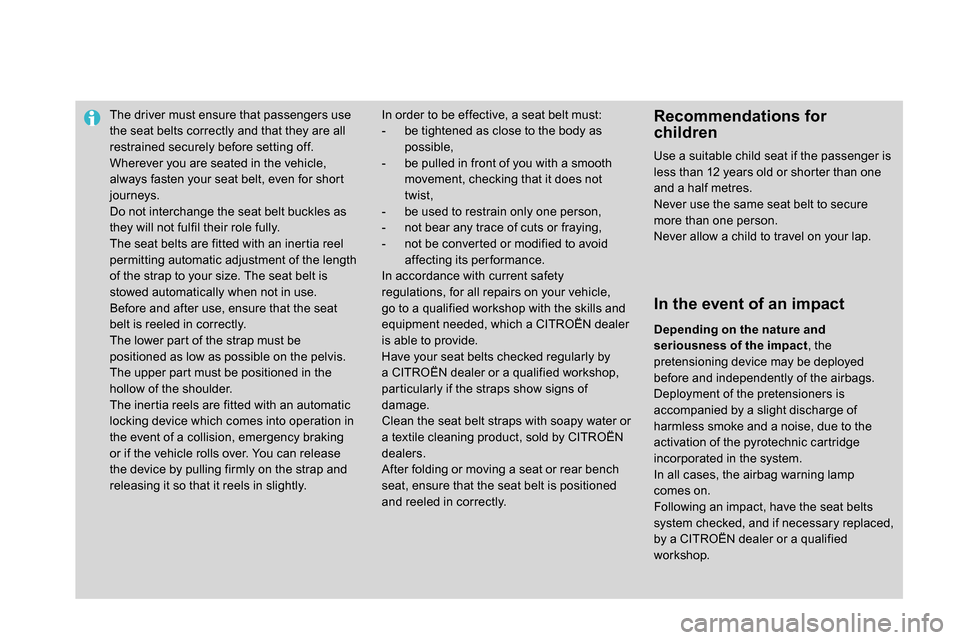
The driver must ensure that passengers use
the seat belts correctly and that they are all
restrained securely before setting off.
Wherever you are seated in the vehicle,
always fasten your seat belt, even for short
journeys.
Do not interchange the seat belt buckles as
they will not fulfil their role fully.
The seat belts are fitted with an inertia reel
permitting automatic adjustment of the length
of the strap to your size. The seat belt is
stowed automatically when not in use.
Before and after use, ensure that the seat
belt is reeled in correctly.
The lower part of the strap must be
positioned as low as possible on the pelvis.
The upper part must be positioned in the
hollow of the shoulder.
The inertia reels are fitted with an automatic
locking device which comes into operation in
the event of a collision, emergency braking
or if the vehicle rolls over. You can release
the device by pulling firmly on the strap and
releasing it so that it reels in slightly. In order to be effective, a seat belt must:
- be tightened as close to the body as
possible,
- be pulled in front of you with a smooth
movement, checking that it does not
twist,
- be used to restrain only one person,
- not bear any trace of cuts or fraying,
- not be converted or modified to avoid
affecting its per formance.
In accordance with current safety
regulations, for all repairs on your vehicle,
go to a qualified workshop with the skills and
equipment needed, which a CITROËN dealer
is able to provide.
Have your seat belts checked regularly by
a CITROËN dealer or a qualified workshop,
particularly if the straps show signs of
damage.
Clean the seat belt straps with soapy water or
a textile cleaning product, sold by CITROËN
dealers.
After folding or moving a seat or rear bench
seat, ensure that the seat belt is positioned
and reeled in correctly.
Recommendations for
children
Use a suitable child seat if the passenger is
less than 12 years old or shorter than one
and a half metres.
Never use the same seat belt to secure
more than one person.
Never allow a child to travel on your lap.
In the event of an impact
Depending on the nature and
seriousness of the impact
, the
pretensioning device may be deployed
before and independently of the airbags.
Deployment of the pretensioners is
accompanied by a slight discharge of
harmless smoke and a noise, due to the
activation of the pyrotechnic cartridge
incorporated in the system.
In all cases, the airbag warning lamp
comes on.
Following an impact, have the seat belts
system checked, and if necessary replaced,
by a CITROËN dealer or a qualified
workshop.
Page 192 of 400
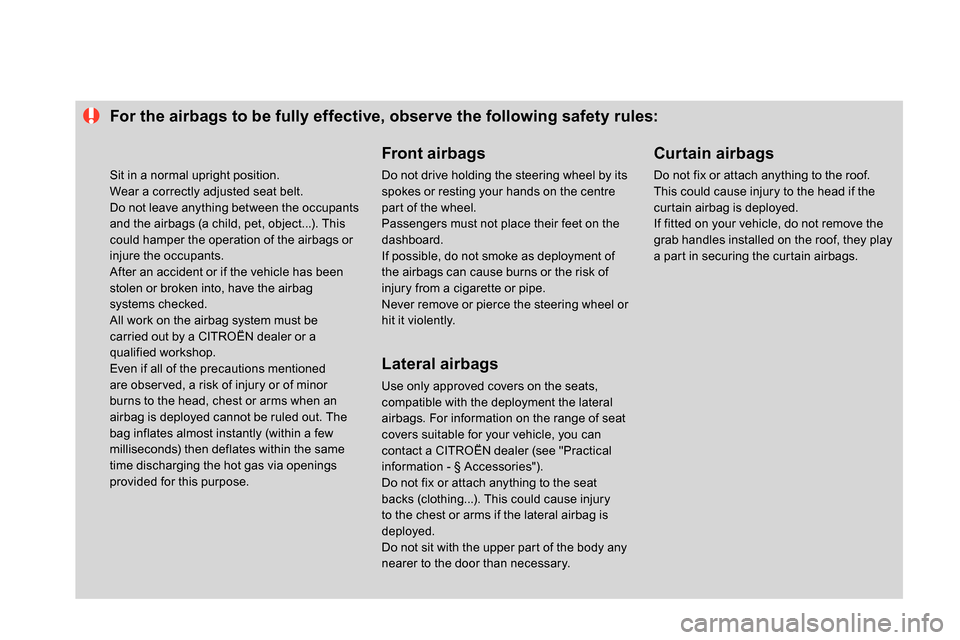
For the airbags to be fully effective, observe the following safety rules:
Front airbags
Do not drive holding the steering wheel by its
spokes or resting your hands on the centre
part of the wheel.
Passengers must not place their feet on the
dashboard.
If possible, do not smoke as deployment of
the airbags can cause burns or the risk of
injury from a cigarette or pipe.
Never remove or pierce the steering wheel or
hit it violently.
Lateral airbags
Use only approved covers on the seats,
compatible with the deployment the lateral
airbags. For information on the range of seat
covers suitable for your vehicle, you can
contact a CITROËN dealer (see "Practical
information - § Accessories").
Do not fix or attach anything to the seat
backs (clothing...). This could cause injury
to the chest or arms if the lateral airbag is
deployed.
Do not sit with the upper part of the body any
nearer to the door than necessary.
Curtain airbags
Do not fix or attach anything to the roof.
This could cause injury to the head if the
curtain airbag is deployed.
If fitted on your vehicle, do not remove the
grab handles installed on the roof, they play
a part in securing the curtain airbags.
Sit in a normal upright position.
Wear a correctly adjusted seat belt.
Do not leave anything between the occupants
and the airbags (a child, pet, object...). This
could hamper the operation of the airbags or
injure the occupants.
After an accident or if the vehicle has been
stolen or broken into, have the airbag
systems checked.
All work on the airbag system must be
carried out by a CITROËN dealer or a
qualified workshop.
Even if all of the precautions mentioned
are obser ved, a risk of injury or of minor
burns to the head, chest or arms when an
airbag is deployed cannot be ruled out. The
bag inflates almost instantly (within a few
milliseconds) then deflates within the same
time discharging the hot gas via openings
provided for this purpose.
Page 237 of 400
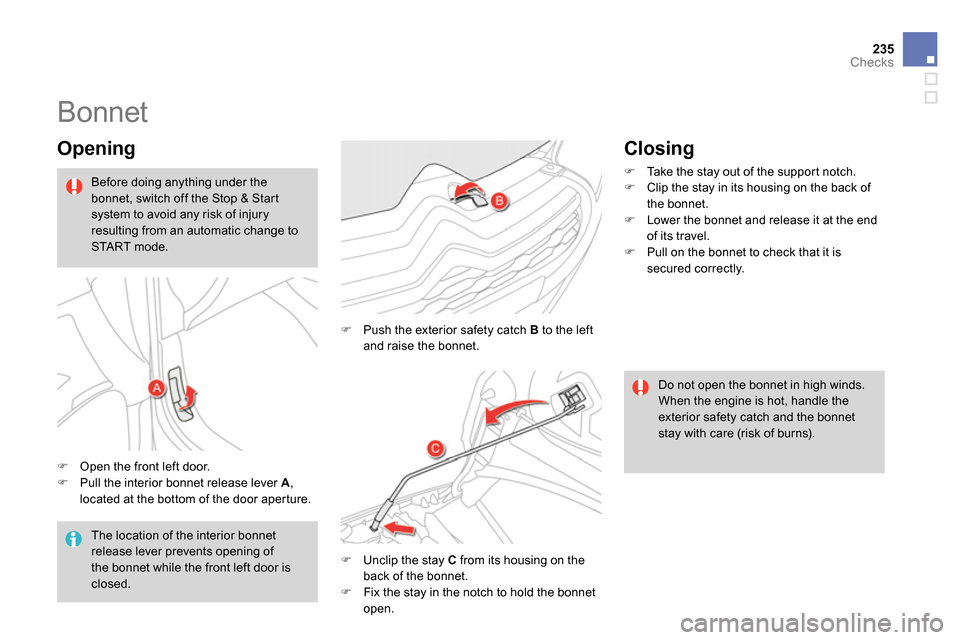
235Checks
Bonnet
Opening
Open the front left door.
Pull the interior bonnet release lever A
,
located at the bottom of the door aperture.
Push the exterior safety catch B
to the left
and raise the bonnet.
Unclip the stay C
from its housing on the
back of the bonnet.
Fix the stay in the notch to hold the bonnet
open.
The location of the interior bonnet
release lever prevents opening of
the bonnet while the front left door is
closed.
Do not open the bonnet in high winds.
When the engine is hot, handle the
exterior safety catch and the bonnet
stay with care (risk of burns).
Before doing anything under the
bonnet, switch off the Stop & Start
system to avoid any risk of injury
resulting from an automatic change to
START mode.
Closing
Take the stay out of the support notch.
Clip the stay in its housing on the back of
the bonnet.
Lower the bonnet and release it at the end
of its travel.
Pull on the bonnet to check that it is
secured correctly.
Page 243 of 400
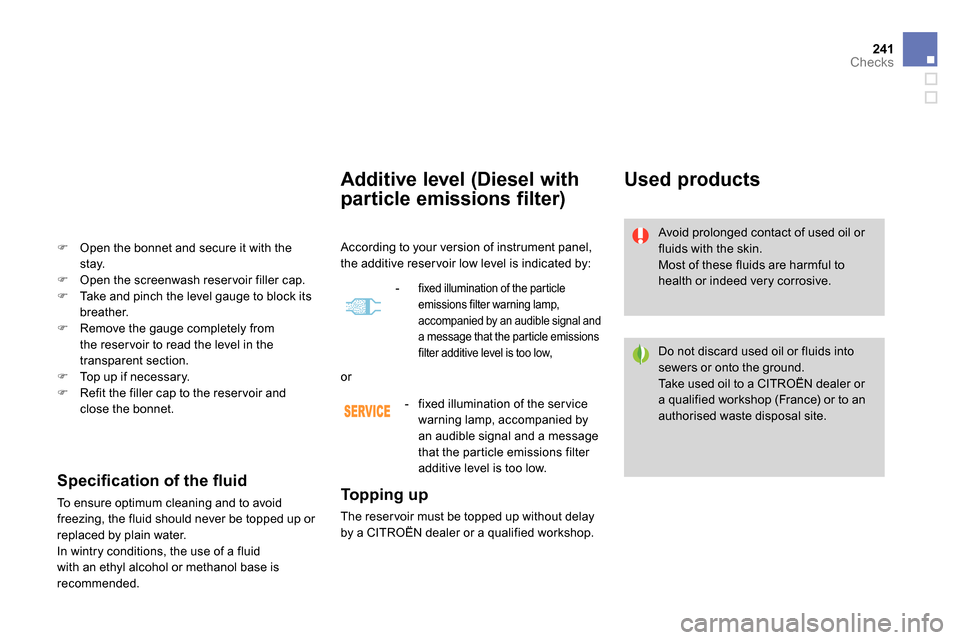
241Checks
Additive level (Diesel with
particle emissions filter)
Topping up
The reser voir must be topped up without delay
by a CITROËN dealer or a qualified workshop.
Used products
Avoid prolonged contact of used oil or
fluids with the skin.
Most of these fluids are harmful to
health or indeed very corrosive.
Do not discard used oil or fluids into
sewers or onto the ground.
Take used oil to a CITROËN dealer or
a qualified workshop (France) or to an
authorised waste disposal site.
Open the bonnet and secure it with the
stay.
Open the screenwash reser voir filler cap.
Take and pinch the level gauge to block its
breather.
Remove the gauge completely from
the reser voir to read the level in the
transparent section.
Top up if necessary.
Refit the filler cap to the reservoir and
close the bonnet.
Specifi cation of the fl uid
To ensure optimum cleaning and to avoid
freezing, the fluid should never be topped up or
replaced by plain water.
In wintry conditions, the use of a fluid
with an ethyl alcohol or methanol base is
recommended.
According to your version of instrument panel,
the additive reser voir low level is indicated by:
-
fixed illumination of the par ticle
emissions filter warning lamp,
accompanied by an audible signal and
a message that the particle emissions
filter additive level is too low,
or
- fixed illumination of the ser vice
warning lamp, accompanied by
an audible signal and a message
that the particle emissions filter
additive level is too low.
Page 255 of 400
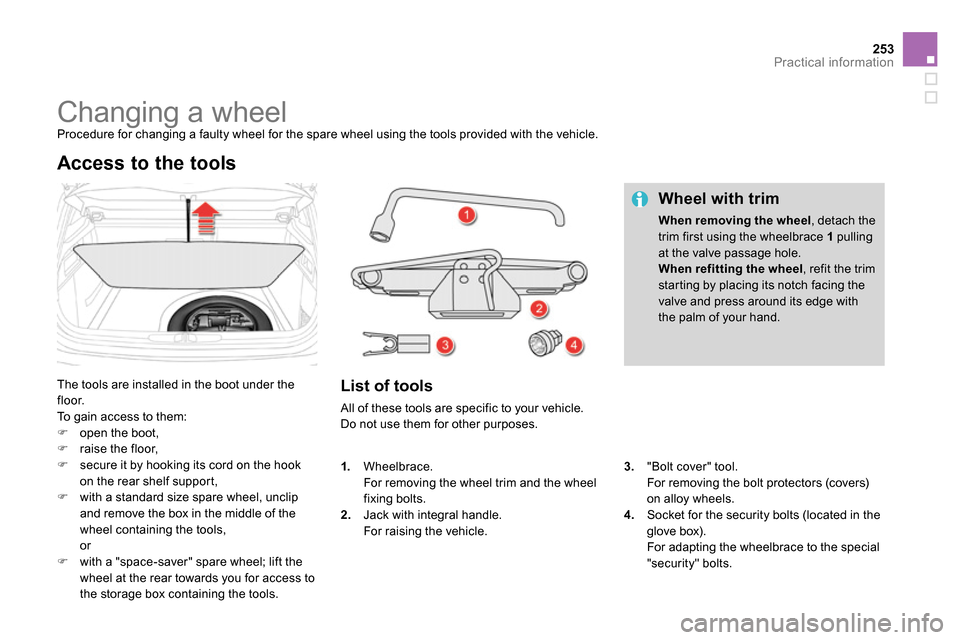
253Practical information
Changing a wheel
Procedure for changing a faulty wheel for the spare wheel using the tools provided with the vehicle.
The tools are installed in the boot under the
floor.
To gain access to them:
open the boot,
raise the floor,
secure it by hooking its cord on the hook
on the rear shelf support,
with a standard size spare wheel, unclip
and remove the box in the middle of the
wheel containing the tools,
or
with a "space-saver" spare wheel; lift the
wheel at the rear towards you for access to
the storage box containing the tools.
Access to the tools
List of tools
All of these tools are specific to your vehicle.
Do not use them for other purposes.
Wheel with trim
When removing the wheel
, detach the
trim first using the wheelbrace 1
pulling
at the valve passage hole.
When refitting the wheel
, refit the trim
starting by placing its notch facing the
valve and press around its edge with
the palm of your hand.
3.
"Bolt cover" tool.
For removing the bolt protectors (covers)
on alloy wheels.
4.
Socket for the security bolts (located in the
glove box).
For adapting the wheelbrace to the special
"security" bolts.
1.
Wheelbrace.
For removing the wheel trim and the wheel
fixing bolts.
2.
Jack with integral handle.
For raising the vehicle.
Page 258 of 400
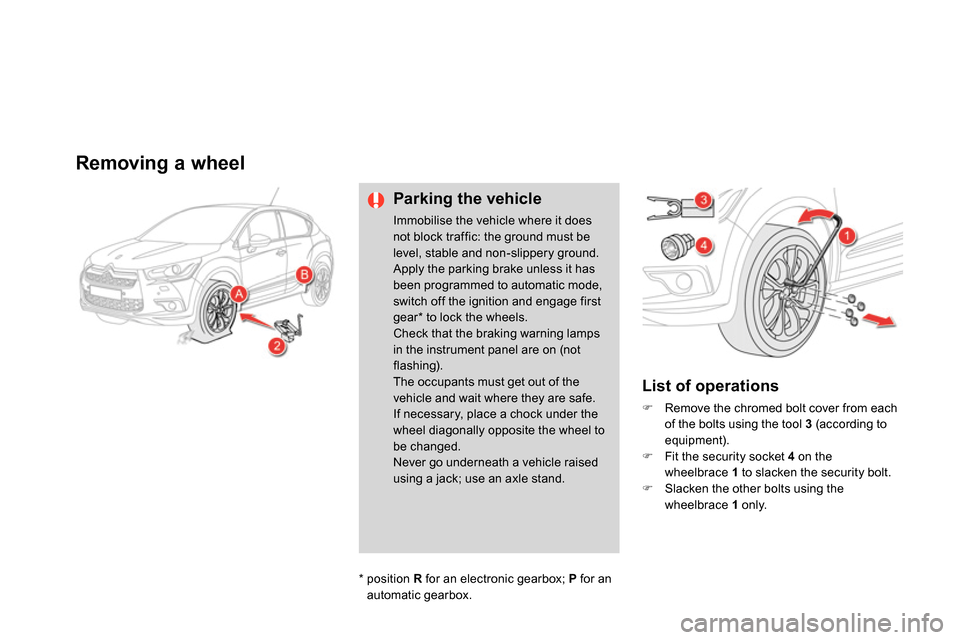
Removing a wheel
Parking the vehicle
Immobilise the vehicle where it does
not block traffic: the ground must be
level, stable and non-slippery ground.
Apply the parking brake unless it has
been programmed to automatic mode,
switch off the ignition and engage first
gear * to lock the wheels.
Check that the braking warning lamps
in the instrument panel are on (not
flashing).
The occupants must get out of the
vehicle and wait where they are safe.
If necessary, place a chock under the
wheel diagonally opposite the wheel to
be changed.
Never go underneath a vehicle raised
using a jack; use an axle stand.
List of operations
Remove the chromed bolt cover from each
of the bolts using the tool 3
(according to
equipment).
Fit the security socket 4
on the
wheelbrace 1
to slacken the security bolt.
Slacken the other bolts using the
wheelbrace 1
only.
*
position R
for an electronic gearbox; P
for an
automatic gearbox.
Page 260 of 400
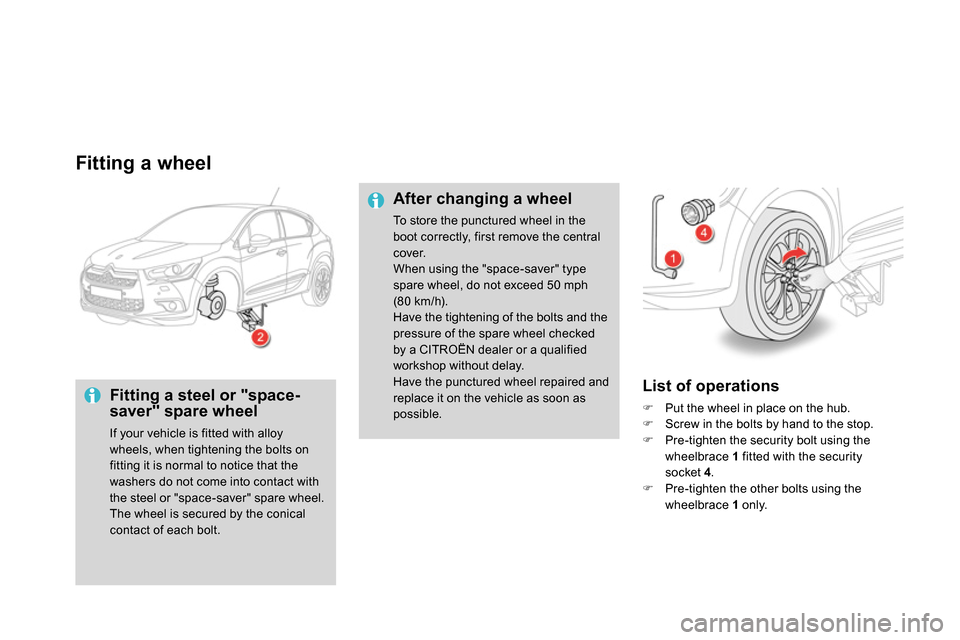
Fitting a wheel
Fitting a steel or "space-
saver" spare wheel
If your vehicle is fitted with alloy
wheels, when tightening the bolts on
fitting it is normal to notice that the
washers do not come into contact with
the steel or "space-saver" spare wheel.
The wheel is secured by the conical
contact of each bolt.
List of operations
Put the wheel in place on the hub.
Screw in the bolts by hand to the stop.
Pre-tighten the security bolt using the
wheelbrace 1
fitted with the security
socket 4
.
Pre-tighten the other bolts using the
wheelbrace 1
only.
After changing a wheel
To store the punctured wheel in the
boot correctly, first remove the central
cover.
When using the "space-saver" type
spare wheel, do not exceed 50 mph
(80 km/h).
Have the tightening of the bolts and the
pressure of the spare wheel checked
by a CITROËN dealer or a qualified
workshop without delay.
Have the punctured wheel repaired and
replace it on the vehicle as soon as
possible.
Page 261 of 400
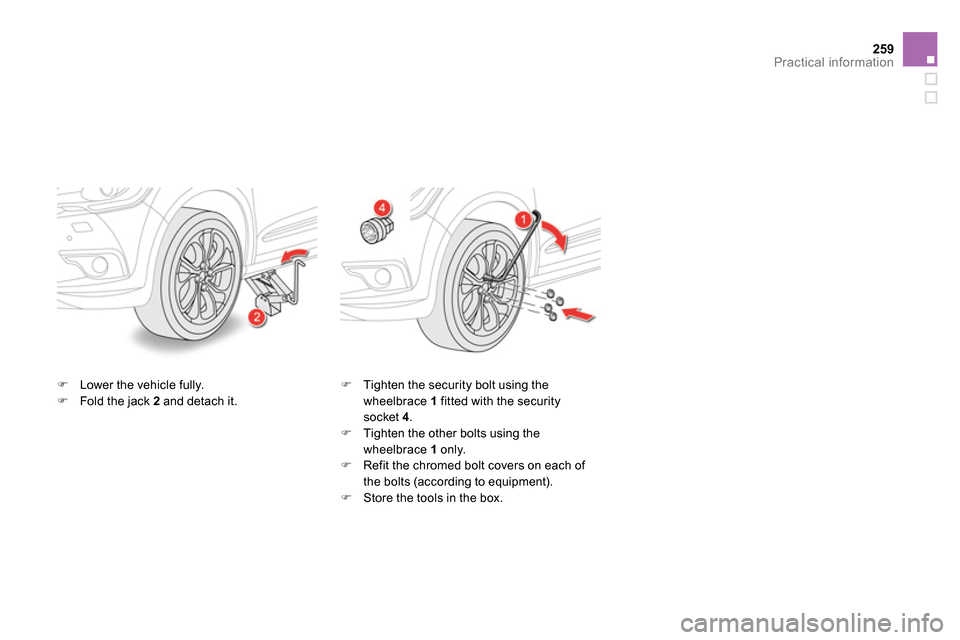
259Practical information
Lower the vehicle fully.
Fold the jack 2
and detach it.
Tighten the security bolt using the
wheelbrace 1
fitted with the security
socket 4
.
Tighten the other bolts using the
wheelbrace 1
only.
Refit the chromed bolt covers on each of
the bolts (according to equipment).
Store the tools in the box.
Page 273 of 400
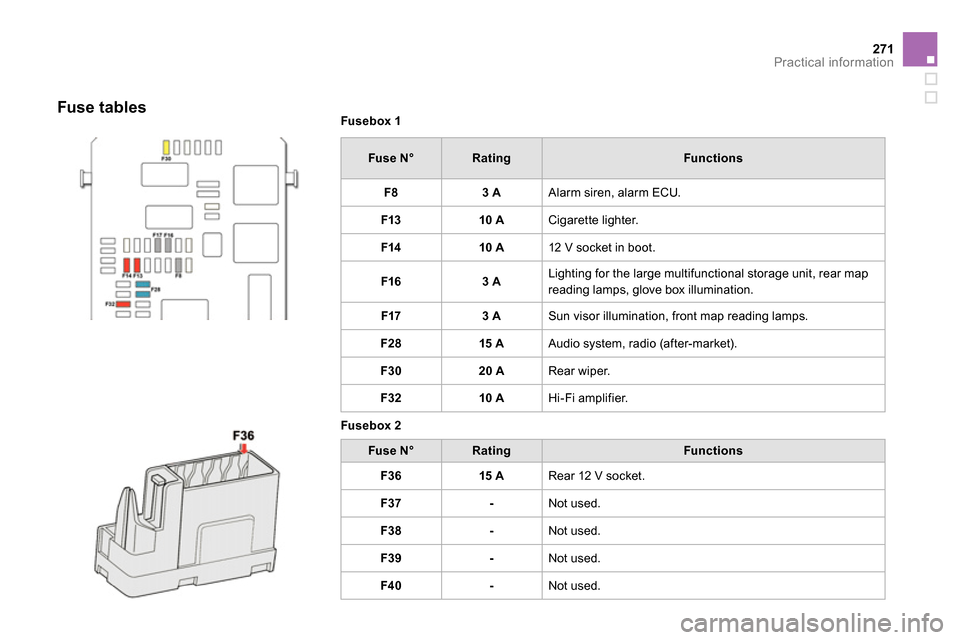
271Practical information
Fusebox 1
Fuse N°
Rating
Functions
F8
3 A
Alarm siren, alarm ECU.
F13
10 A
Cigarette lighter.
F14
10 A
12 V socket in boot.
F16
3 A
Lighting for the large multifunctional storage unit, rear map
reading lamps, glove box illumination.
F17
3 A
Sun visor illumination, front map reading lamps.
F28
15 A
Audio system, radio (after-market).
F30
20 A
Rear wiper.
F32
10 A
Hi-Fi amplifier.
Fusebox 2
Fuse N°
Rating
Functions
F36
15 A
Rear 12 V socket.
F37
-
Not used.
F38
-
Not used.
F39
-
Not used.
F40
-
Not used.
Fuse tables